Data Analysis and Report: Quantitative Study on Footwear Interface
VerifiedAdded on 2023/06/11
|9
|1372
|420
Report
AI Summary
This report presents a quantitative analysis of data collected from a footwear user study, focusing on the impact of audio feedback on user behavior. The analysis employs statistical techniques such as confidence intervals and hypothesis testing to evaluate the influence of different audio frequencies on galvanic skin response, emotional valence, perceived arousal, dominance, and speed control. The findings suggest that audio frequency does not significantly impact galvanic skin response or the proportion of individuals with positive emotional valence. Furthermore, the study indicates that audio frequency has an insignificant influence on perceptions of speed control, dominance, and arousal, as evidenced by overlapping confidence intervals. The report acknowledges limitations such as potential sample bias and gender representation, recommending further research with larger, more representative samples to draw more definitive conclusions about the impact of footwear audio interfaces on user behavior. Desklib provides this report as a valuable resource, offering students access to solved assignments and past papers to aid in their studies.
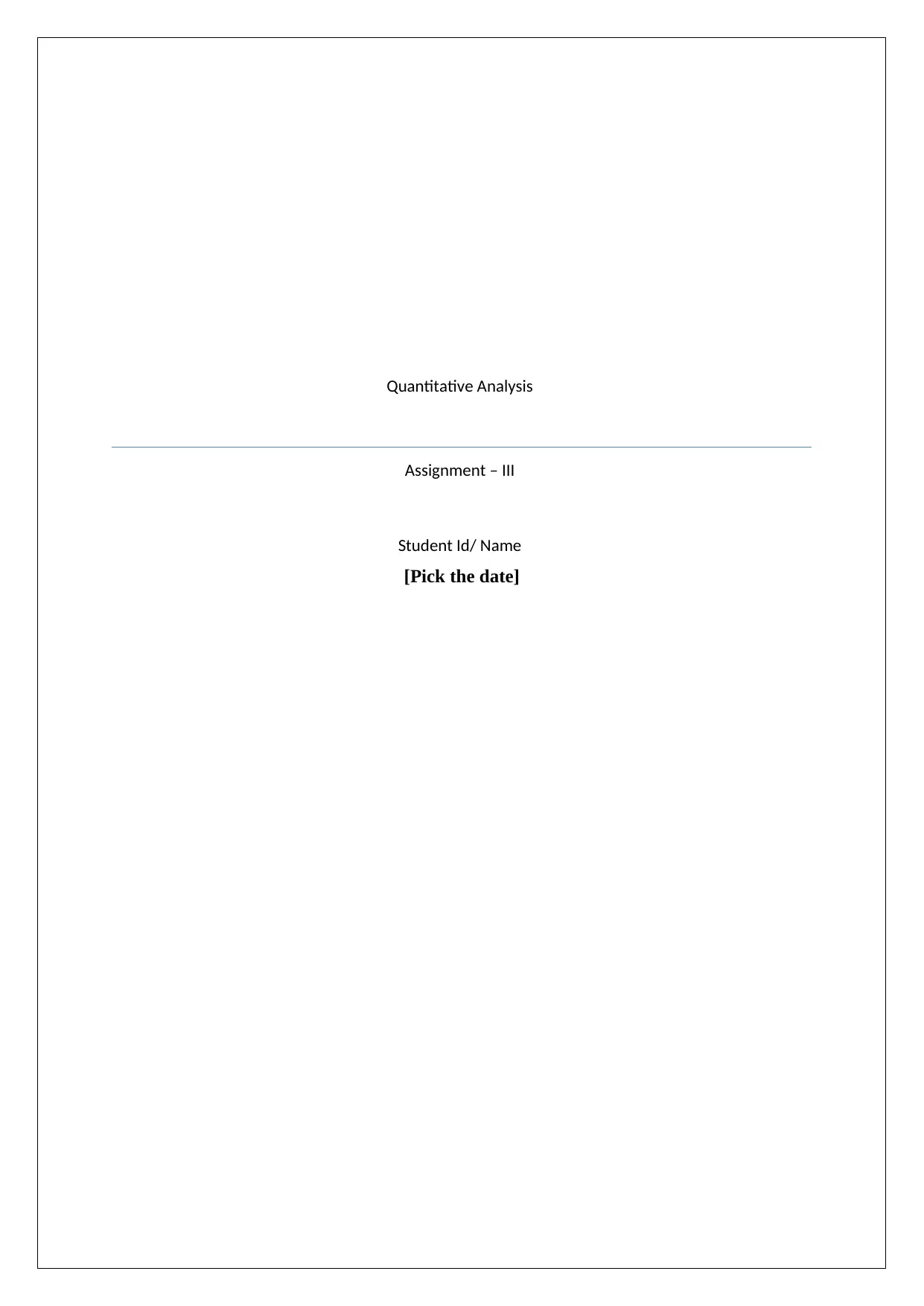
Quantitative Analysis
Assignment – III
Student Id/ Name
[Pick the date]
Assignment – III
Student Id/ Name
[Pick the date]
Paraphrase This Document
Need a fresh take? Get an instant paraphrase of this document with our AI Paraphraser
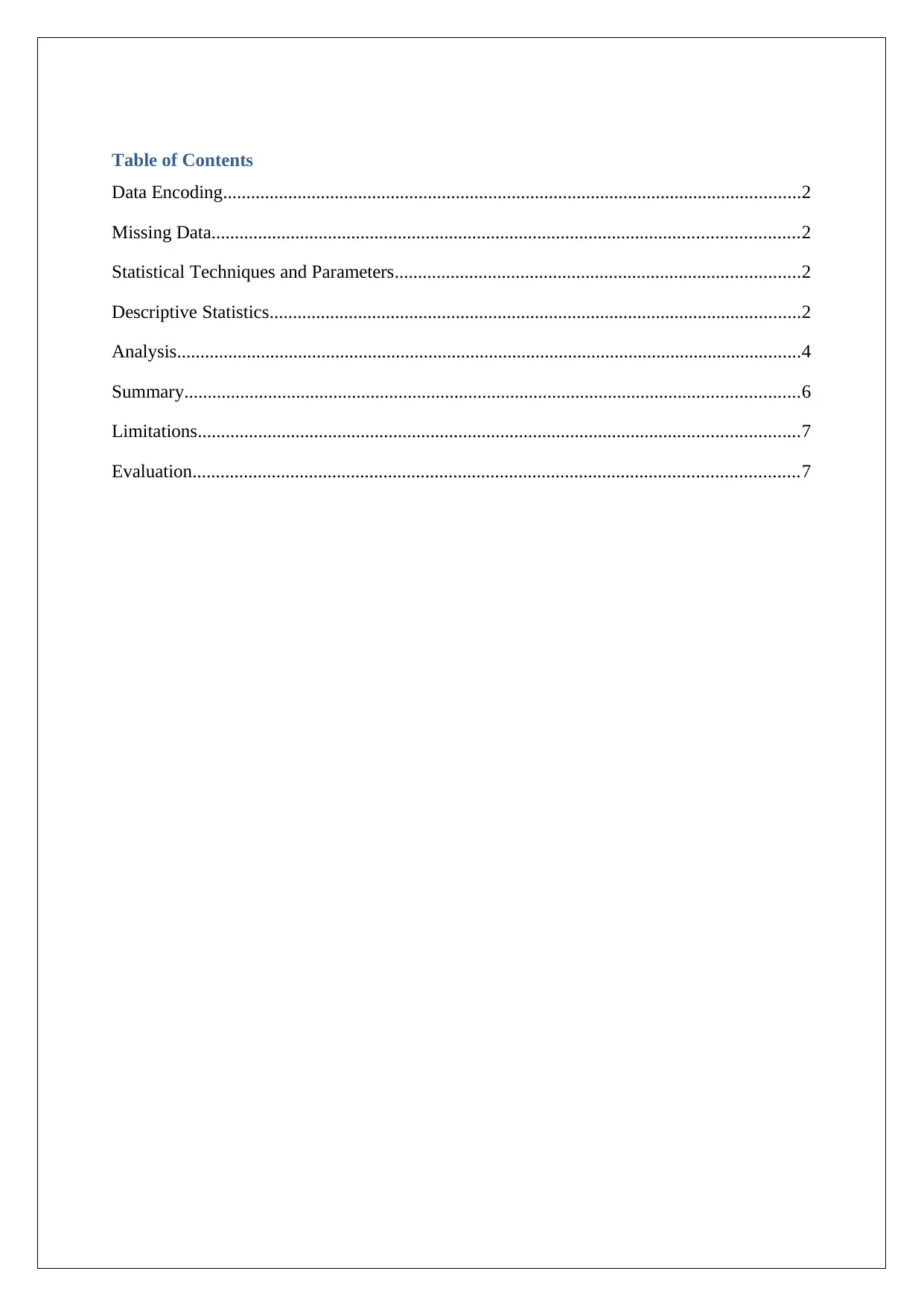
Table of Contents
Data Encoding............................................................................................................................2
Missing Data..............................................................................................................................2
Statistical Techniques and Parameters.......................................................................................2
Descriptive Statistics..................................................................................................................2
Analysis......................................................................................................................................4
Summary....................................................................................................................................6
Limitations.................................................................................................................................7
Evaluation..................................................................................................................................7
Data Encoding............................................................................................................................2
Missing Data..............................................................................................................................2
Statistical Techniques and Parameters.......................................................................................2
Descriptive Statistics..................................................................................................................2
Analysis......................................................................................................................................4
Summary....................................................................................................................................6
Limitations.................................................................................................................................7
Evaluation..................................................................................................................................7
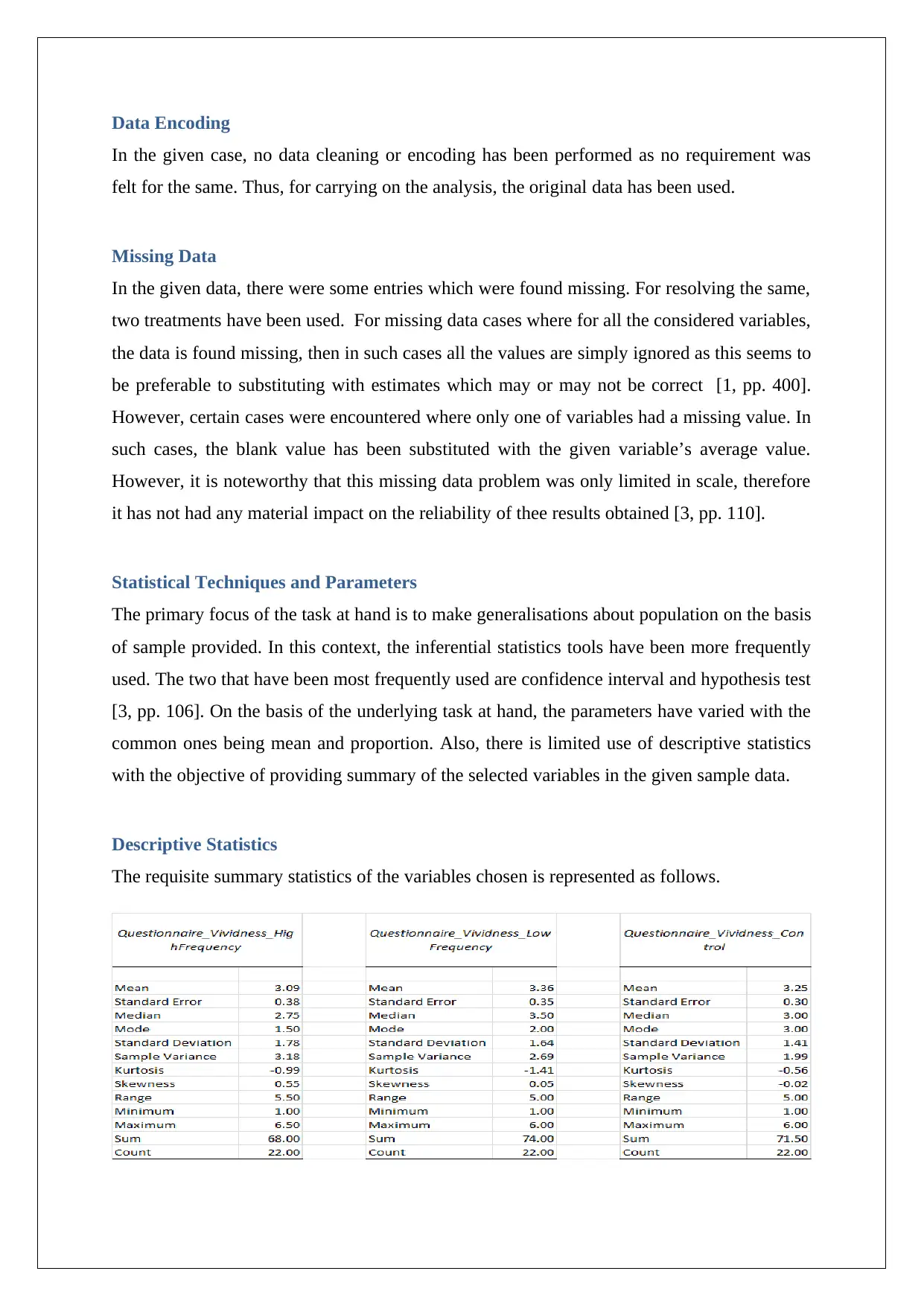
Data Encoding
In the given case, no data cleaning or encoding has been performed as no requirement was
felt for the same. Thus, for carrying on the analysis, the original data has been used.
Missing Data
In the given data, there were some entries which were found missing. For resolving the same,
two treatments have been used. For missing data cases where for all the considered variables,
the data is found missing, then in such cases all the values are simply ignored as this seems to
be preferable to substituting with estimates which may or may not be correct [1, pp. 400].
However, certain cases were encountered where only one of variables had a missing value. In
such cases, the blank value has been substituted with the given variable’s average value.
However, it is noteworthy that this missing data problem was only limited in scale, therefore
it has not had any material impact on the reliability of thee results obtained [3, pp. 110].
Statistical Techniques and Parameters
The primary focus of the task at hand is to make generalisations about population on the basis
of sample provided. In this context, the inferential statistics tools have been more frequently
used. The two that have been most frequently used are confidence interval and hypothesis test
[3, pp. 106]. On the basis of the underlying task at hand, the parameters have varied with the
common ones being mean and proportion. Also, there is limited use of descriptive statistics
with the objective of providing summary of the selected variables in the given sample data.
Descriptive Statistics
The requisite summary statistics of the variables chosen is represented as follows.
In the given case, no data cleaning or encoding has been performed as no requirement was
felt for the same. Thus, for carrying on the analysis, the original data has been used.
Missing Data
In the given data, there were some entries which were found missing. For resolving the same,
two treatments have been used. For missing data cases where for all the considered variables,
the data is found missing, then in such cases all the values are simply ignored as this seems to
be preferable to substituting with estimates which may or may not be correct [1, pp. 400].
However, certain cases were encountered where only one of variables had a missing value. In
such cases, the blank value has been substituted with the given variable’s average value.
However, it is noteworthy that this missing data problem was only limited in scale, therefore
it has not had any material impact on the reliability of thee results obtained [3, pp. 110].
Statistical Techniques and Parameters
The primary focus of the task at hand is to make generalisations about population on the basis
of sample provided. In this context, the inferential statistics tools have been more frequently
used. The two that have been most frequently used are confidence interval and hypothesis test
[3, pp. 106]. On the basis of the underlying task at hand, the parameters have varied with the
common ones being mean and proportion. Also, there is limited use of descriptive statistics
with the objective of providing summary of the selected variables in the given sample data.
Descriptive Statistics
The requisite summary statistics of the variables chosen is represented as follows.
⊘ This is a preview!⊘
Do you want full access?
Subscribe today to unlock all pages.

Trusted by 1+ million students worldwide
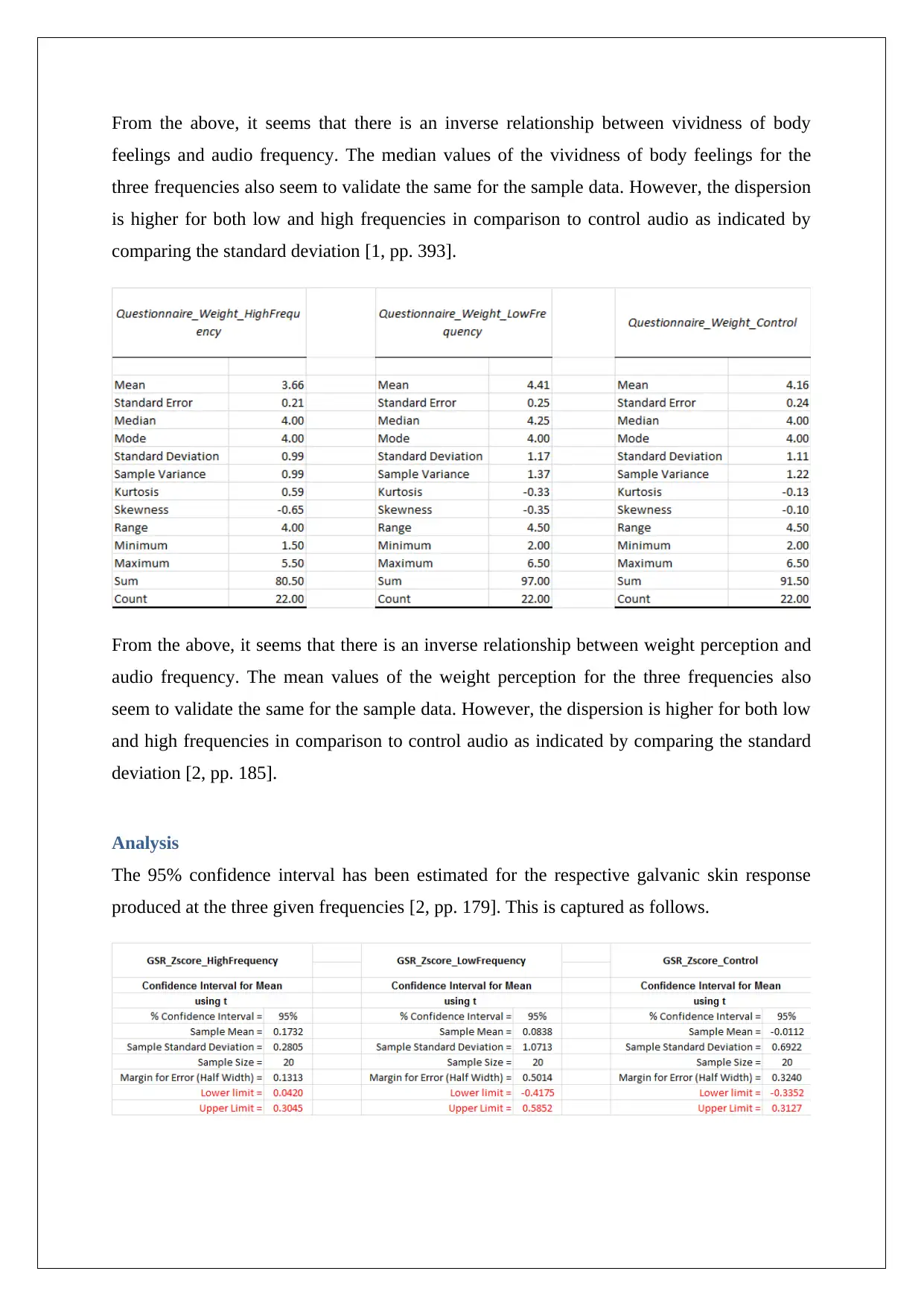
From the above, it seems that there is an inverse relationship between vividness of body
feelings and audio frequency. The median values of the vividness of body feelings for the
three frequencies also seem to validate the same for the sample data. However, the dispersion
is higher for both low and high frequencies in comparison to control audio as indicated by
comparing the standard deviation [1, pp. 393].
From the above, it seems that there is an inverse relationship between weight perception and
audio frequency. The mean values of the weight perception for the three frequencies also
seem to validate the same for the sample data. However, the dispersion is higher for both low
and high frequencies in comparison to control audio as indicated by comparing the standard
deviation [2, pp. 185].
Analysis
The 95% confidence interval has been estimated for the respective galvanic skin response
produced at the three given frequencies [2, pp. 179]. This is captured as follows.
feelings and audio frequency. The median values of the vividness of body feelings for the
three frequencies also seem to validate the same for the sample data. However, the dispersion
is higher for both low and high frequencies in comparison to control audio as indicated by
comparing the standard deviation [1, pp. 393].
From the above, it seems that there is an inverse relationship between weight perception and
audio frequency. The mean values of the weight perception for the three frequencies also
seem to validate the same for the sample data. However, the dispersion is higher for both low
and high frequencies in comparison to control audio as indicated by comparing the standard
deviation [2, pp. 185].
Analysis
The 95% confidence interval has been estimated for the respective galvanic skin response
produced at the three given frequencies [2, pp. 179]. This is captured as follows.
Paraphrase This Document
Need a fresh take? Get an instant paraphrase of this document with our AI Paraphraser
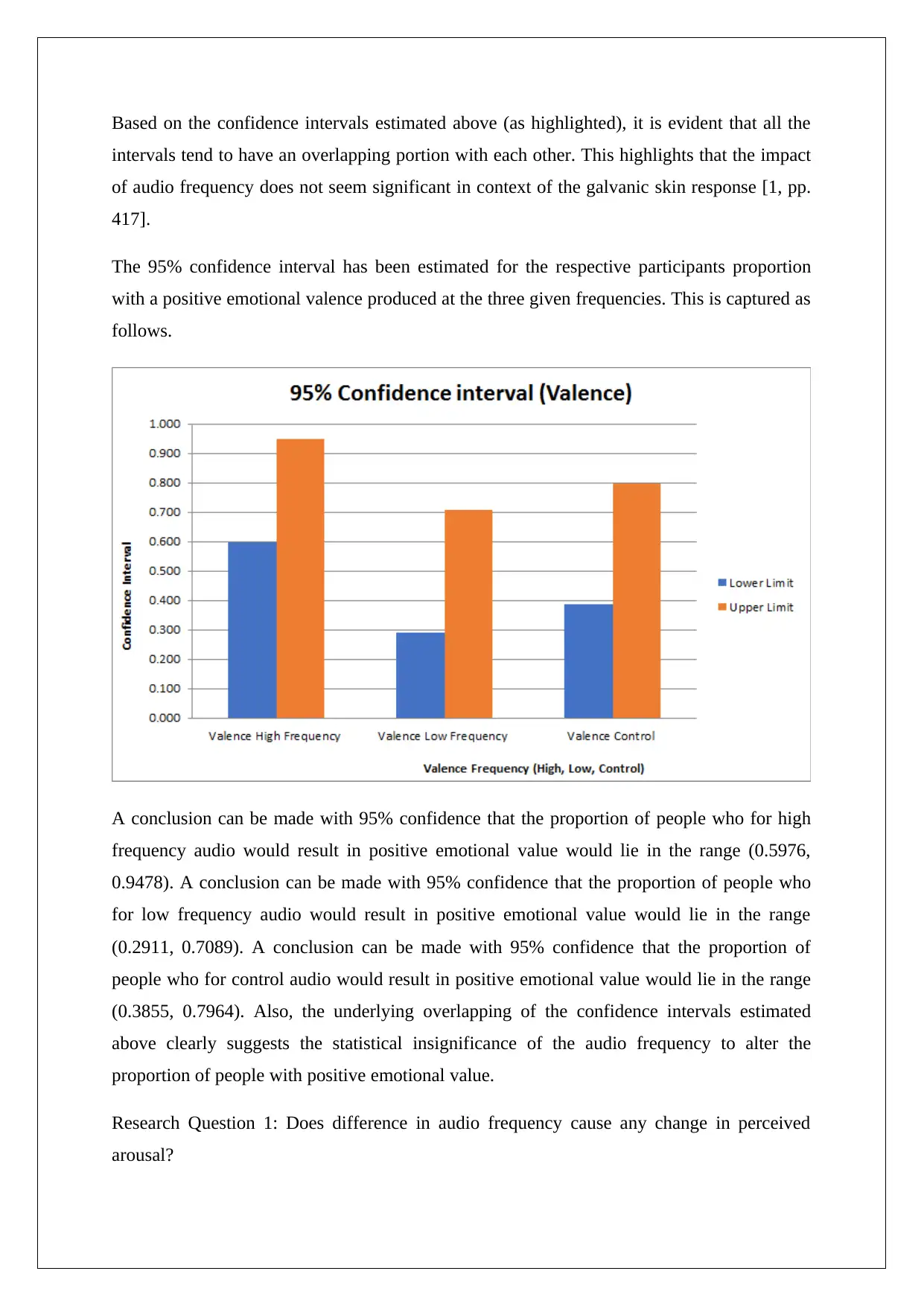
Based on the confidence intervals estimated above (as highlighted), it is evident that all the
intervals tend to have an overlapping portion with each other. This highlights that the impact
of audio frequency does not seem significant in context of the galvanic skin response [1, pp.
417].
The 95% confidence interval has been estimated for the respective participants proportion
with a positive emotional valence produced at the three given frequencies. This is captured as
follows.
A conclusion can be made with 95% confidence that the proportion of people who for high
frequency audio would result in positive emotional value would lie in the range (0.5976,
0.9478). A conclusion can be made with 95% confidence that the proportion of people who
for low frequency audio would result in positive emotional value would lie in the range
(0.2911, 0.7089). A conclusion can be made with 95% confidence that the proportion of
people who for control audio would result in positive emotional value would lie in the range
(0.3855, 0.7964). Also, the underlying overlapping of the confidence intervals estimated
above clearly suggests the statistical insignificance of the audio frequency to alter the
proportion of people with positive emotional value.
Research Question 1: Does difference in audio frequency cause any change in perceived
arousal?
intervals tend to have an overlapping portion with each other. This highlights that the impact
of audio frequency does not seem significant in context of the galvanic skin response [1, pp.
417].
The 95% confidence interval has been estimated for the respective participants proportion
with a positive emotional valence produced at the three given frequencies. This is captured as
follows.
A conclusion can be made with 95% confidence that the proportion of people who for high
frequency audio would result in positive emotional value would lie in the range (0.5976,
0.9478). A conclusion can be made with 95% confidence that the proportion of people who
for low frequency audio would result in positive emotional value would lie in the range
(0.2911, 0.7089). A conclusion can be made with 95% confidence that the proportion of
people who for control audio would result in positive emotional value would lie in the range
(0.3855, 0.7964). Also, the underlying overlapping of the confidence intervals estimated
above clearly suggests the statistical insignificance of the audio frequency to alter the
proportion of people with positive emotional value.
Research Question 1: Does difference in audio frequency cause any change in perceived
arousal?
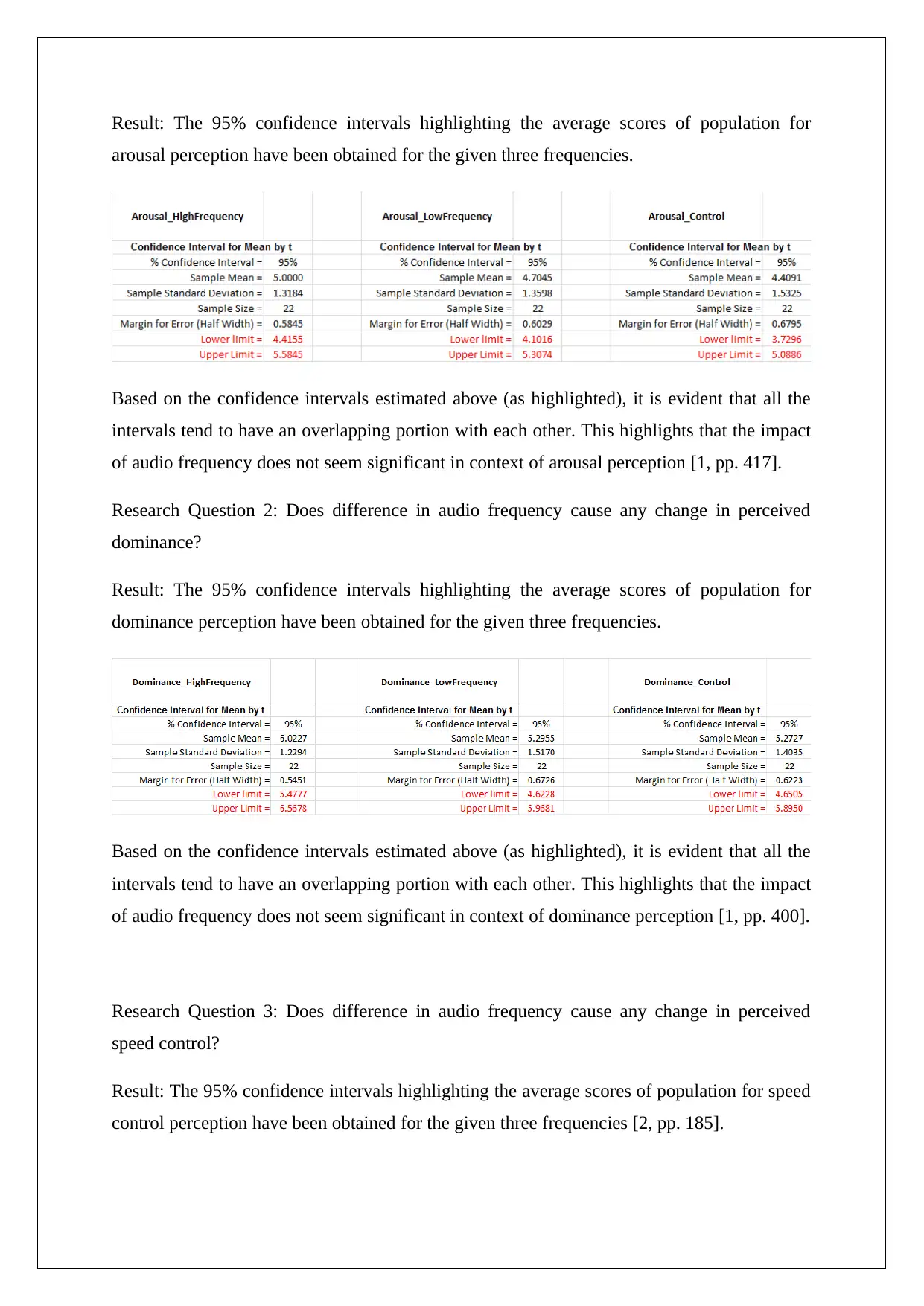
Result: The 95% confidence intervals highlighting the average scores of population for
arousal perception have been obtained for the given three frequencies.
Based on the confidence intervals estimated above (as highlighted), it is evident that all the
intervals tend to have an overlapping portion with each other. This highlights that the impact
of audio frequency does not seem significant in context of arousal perception [1, pp. 417].
Research Question 2: Does difference in audio frequency cause any change in perceived
dominance?
Result: The 95% confidence intervals highlighting the average scores of population for
dominance perception have been obtained for the given three frequencies.
Based on the confidence intervals estimated above (as highlighted), it is evident that all the
intervals tend to have an overlapping portion with each other. This highlights that the impact
of audio frequency does not seem significant in context of dominance perception [1, pp. 400].
Research Question 3: Does difference in audio frequency cause any change in perceived
speed control?
Result: The 95% confidence intervals highlighting the average scores of population for speed
control perception have been obtained for the given three frequencies [2, pp. 185].
arousal perception have been obtained for the given three frequencies.
Based on the confidence intervals estimated above (as highlighted), it is evident that all the
intervals tend to have an overlapping portion with each other. This highlights that the impact
of audio frequency does not seem significant in context of arousal perception [1, pp. 417].
Research Question 2: Does difference in audio frequency cause any change in perceived
dominance?
Result: The 95% confidence intervals highlighting the average scores of population for
dominance perception have been obtained for the given three frequencies.
Based on the confidence intervals estimated above (as highlighted), it is evident that all the
intervals tend to have an overlapping portion with each other. This highlights that the impact
of audio frequency does not seem significant in context of dominance perception [1, pp. 400].
Research Question 3: Does difference in audio frequency cause any change in perceived
speed control?
Result: The 95% confidence intervals highlighting the average scores of population for speed
control perception have been obtained for the given three frequencies [2, pp. 185].
⊘ This is a preview!⊘
Do you want full access?
Subscribe today to unlock all pages.

Trusted by 1+ million students worldwide
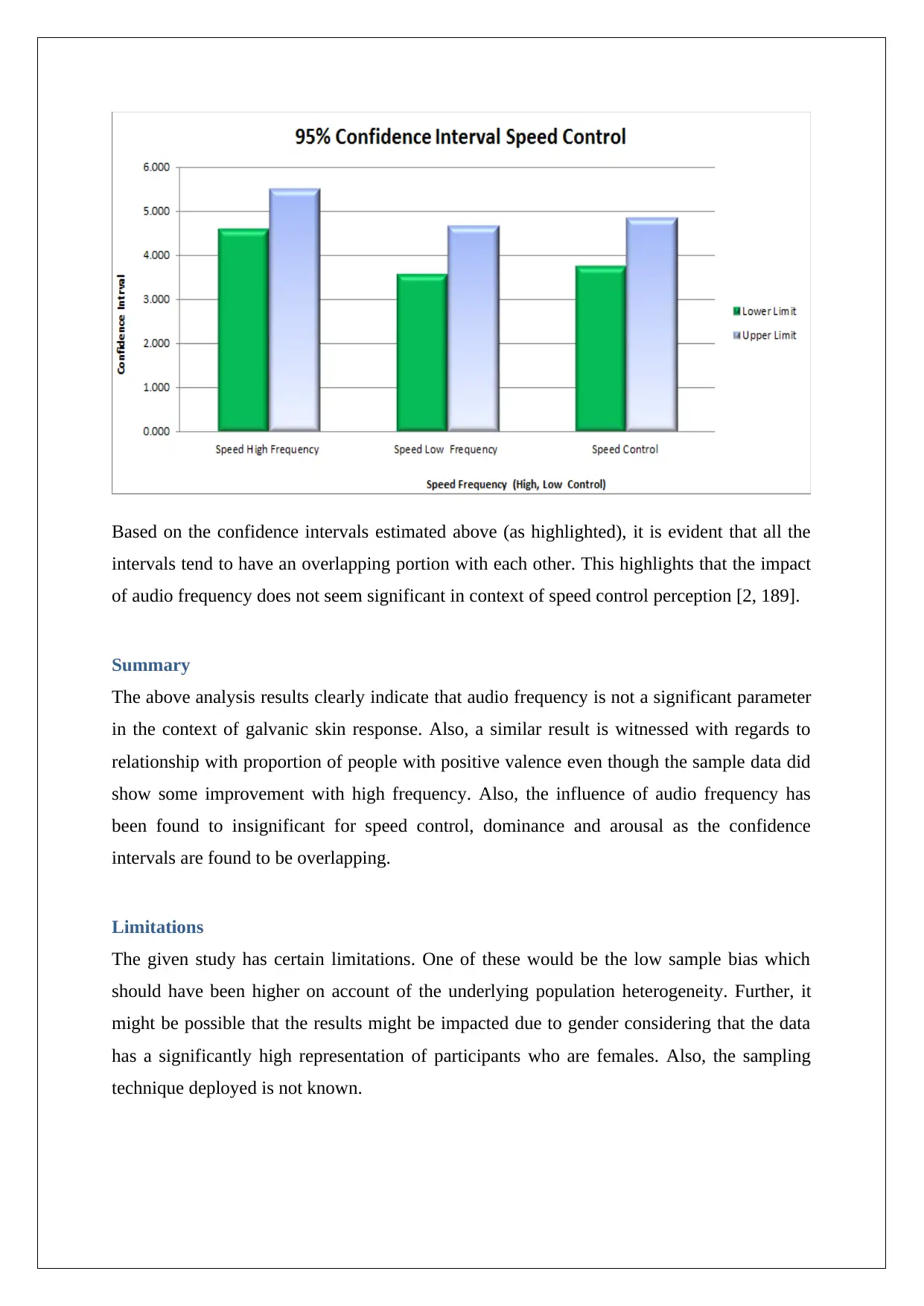
Based on the confidence intervals estimated above (as highlighted), it is evident that all the
intervals tend to have an overlapping portion with each other. This highlights that the impact
of audio frequency does not seem significant in context of speed control perception [2, 189].
Summary
The above analysis results clearly indicate that audio frequency is not a significant parameter
in the context of galvanic skin response. Also, a similar result is witnessed with regards to
relationship with proportion of people with positive valence even though the sample data did
show some improvement with high frequency. Also, the influence of audio frequency has
been found to insignificant for speed control, dominance and arousal as the confidence
intervals are found to be overlapping.
Limitations
The given study has certain limitations. One of these would be the low sample bias which
should have been higher on account of the underlying population heterogeneity. Further, it
might be possible that the results might be impacted due to gender considering that the data
has a significantly high representation of participants who are females. Also, the sampling
technique deployed is not known.
intervals tend to have an overlapping portion with each other. This highlights that the impact
of audio frequency does not seem significant in context of speed control perception [2, 189].
Summary
The above analysis results clearly indicate that audio frequency is not a significant parameter
in the context of galvanic skin response. Also, a similar result is witnessed with regards to
relationship with proportion of people with positive valence even though the sample data did
show some improvement with high frequency. Also, the influence of audio frequency has
been found to insignificant for speed control, dominance and arousal as the confidence
intervals are found to be overlapping.
Limitations
The given study has certain limitations. One of these would be the low sample bias which
should have been higher on account of the underlying population heterogeneity. Further, it
might be possible that the results might be impacted due to gender considering that the data
has a significantly high representation of participants who are females. Also, the sampling
technique deployed is not known.
Paraphrase This Document
Need a fresh take? Get an instant paraphrase of this document with our AI Paraphraser

Evaluation
Useful information does emerge from the given study despite issues with the sample size and
sampling technique. Considering that sample values do tend to show that user behaviour may
be impacted by the audio interface of footwear, it is essential that more extensive research
with greater sample sizes and probability sampling techniques need to be conducted so as to
derive meaningful conclusions in this regards.
Useful information does emerge from the given study despite issues with the sample size and
sampling technique. Considering that sample values do tend to show that user behaviour may
be impacted by the audio interface of footwear, it is essential that more extensive research
with greater sample sizes and probability sampling techniques need to be conducted so as to
derive meaningful conclusions in this regards.
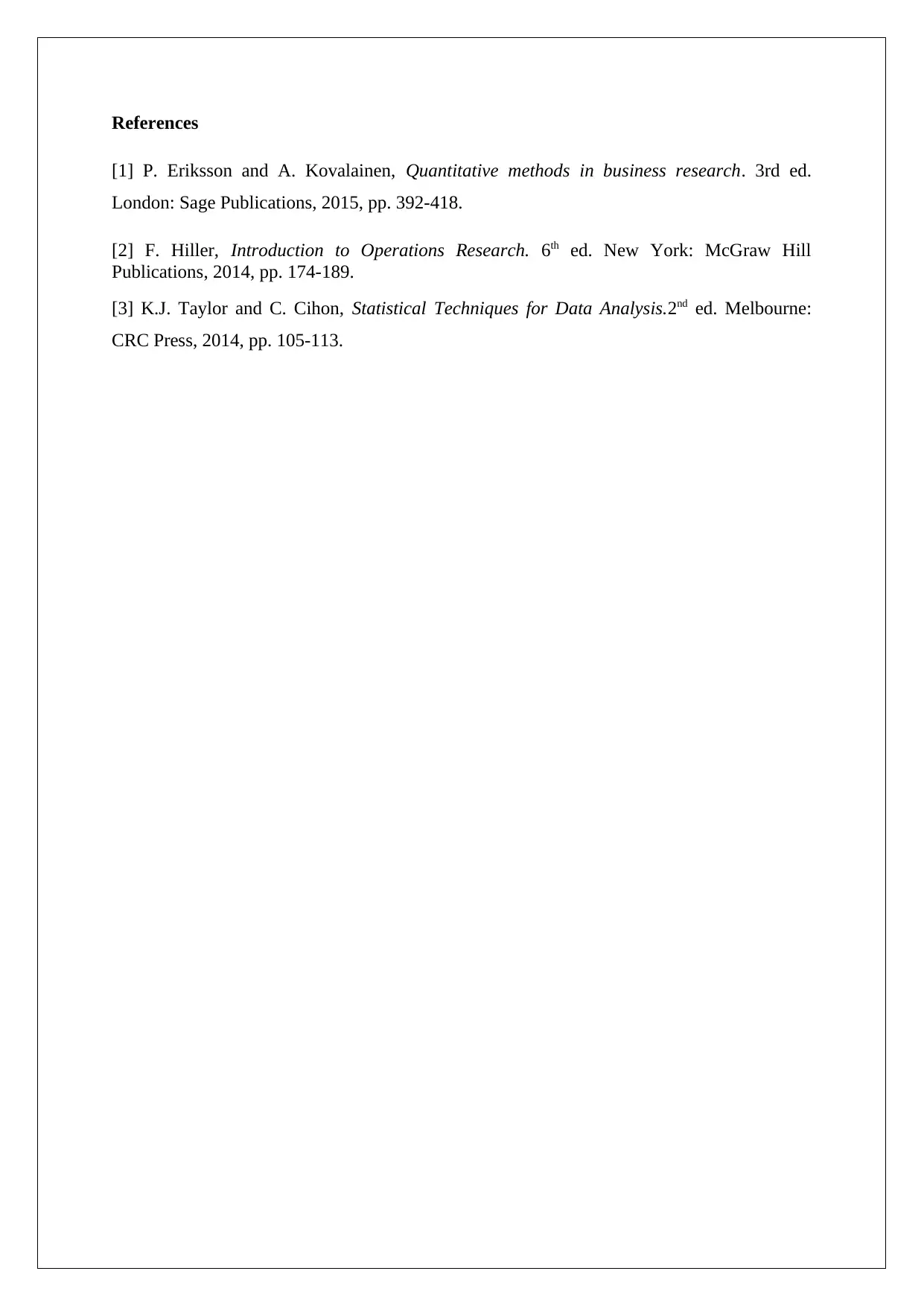
References
[1] P. Eriksson and A. Kovalainen, Quantitative methods in business research. 3rd ed.
London: Sage Publications, 2015, pp. 392-418.
[2] F. Hiller, Introduction to Operations Research. 6th ed. New York: McGraw Hill
Publications, 2014, pp. 174-189.
[3] K.J. Taylor and C. Cihon, Statistical Techniques for Data Analysis.2nd ed. Melbourne:
CRC Press, 2014, pp. 105-113.
[1] P. Eriksson and A. Kovalainen, Quantitative methods in business research. 3rd ed.
London: Sage Publications, 2015, pp. 392-418.
[2] F. Hiller, Introduction to Operations Research. 6th ed. New York: McGraw Hill
Publications, 2014, pp. 174-189.
[3] K.J. Taylor and C. Cihon, Statistical Techniques for Data Analysis.2nd ed. Melbourne:
CRC Press, 2014, pp. 105-113.
⊘ This is a preview!⊘
Do you want full access?
Subscribe today to unlock all pages.

Trusted by 1+ million students worldwide
1 out of 9
Related Documents
Your All-in-One AI-Powered Toolkit for Academic Success.
+13062052269
info@desklib.com
Available 24*7 on WhatsApp / Email
![[object Object]](/_next/static/media/star-bottom.7253800d.svg)
Unlock your academic potential
Copyright © 2020–2025 A2Z Services. All Rights Reserved. Developed and managed by ZUCOL.





